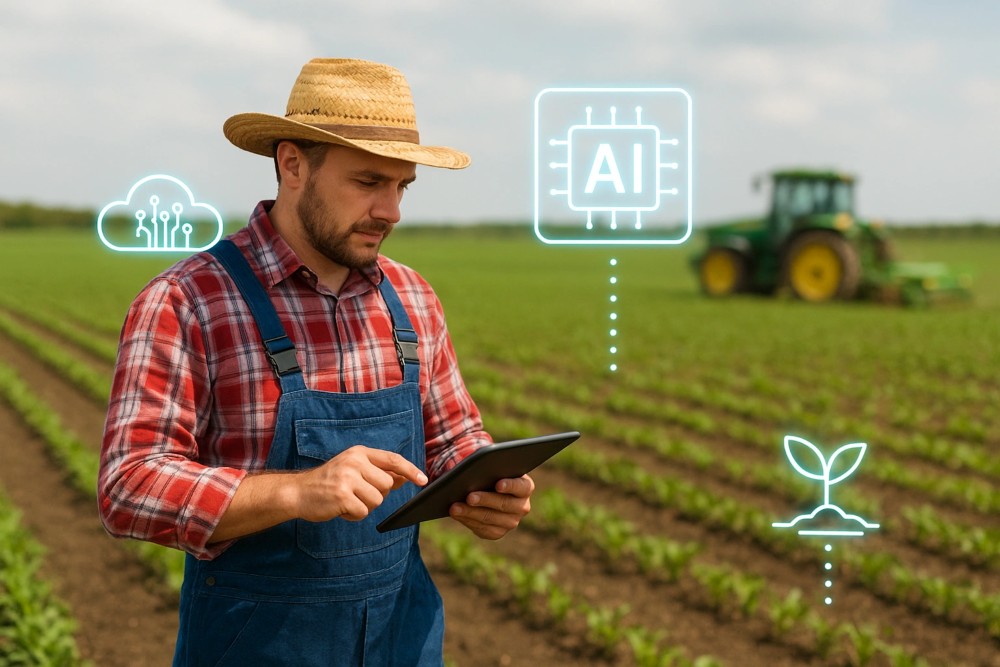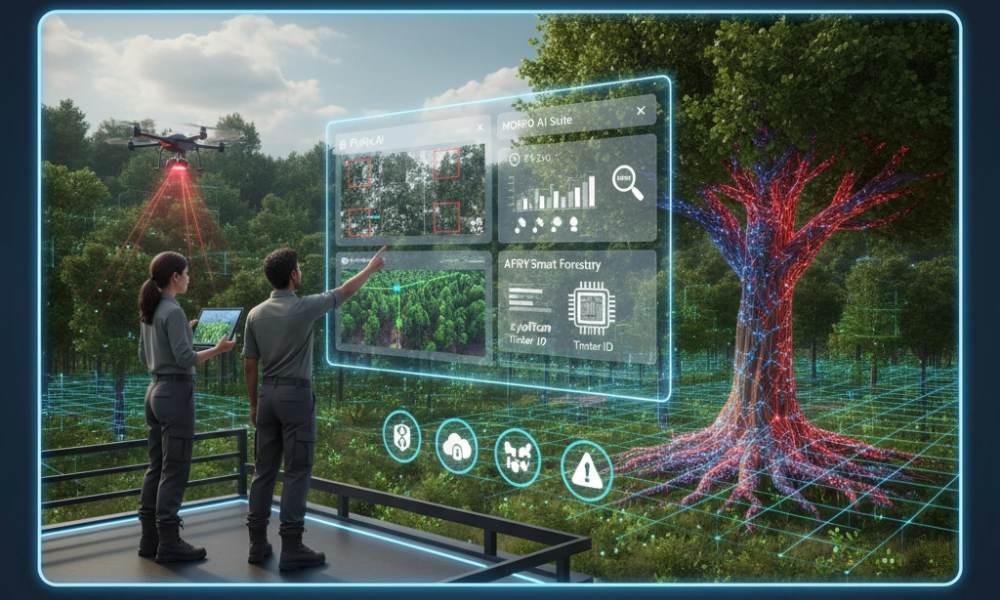
Forest Management Software & AI Tools: Smarter Solutions for Sustainable Forestry
- September 19, 2025
- Top Search
- 10:53 am

Quick Overview
AI is revolutionizing forestry with powerful tools for monitoring, inventory, reforestation, and timber tracking. From FlyPix to XyloTron, here are 10 leading AI solutions driving sustainable forest management in 2025.
Forests are among the most vital ecosystems on Earth. They absorb carbon dioxide, regulate climate, protect biodiversity, and provide livelihoods for millions of people. Yet, they face increasing pressure from deforestation, climate change, and unsustainable land use. Managing forests sustainably has become a global priority.
In the digital era, Artificial Intelligence (AI) and forest management software tools are reshaping how we monitor, protect, and restore forests. From analyzing satellite images to predicting wildfire risks, AI tools provide unprecedented accuracy, speed, and insights for decision-making.
This blog explores the top 10 AI-powered tools for forest management in 2025, covering their features, applications, and how they contribute to a more sustainable future.
1.FlyPix AI – Advanced Geospatial Intelligence
Website: flypix.ai
FlyPix AI specializes in object detection and geospatial analysis for environmental monitoring. Using AI-powered algorithms, it processes satellite and drone imagery to detect land-use changes, monitor forest cover, and track reforestation progress.
- Key Features
- AI-powered tree detection and classification
- Multispectral image analysis
- Cloud-based geospatial data sharing
- AI-powered tree detection and classification
- Use Cases
- Detecting illegal logging
- Carbon credit validation
- Long-term forest cover monitoring
- Detecting illegal logging
👉 Why it matters: By automating large-scale forest assessments, FlyPix saves countless hours of manual mapping while improving accuracy.
2.MORFO AI Suite – Monitoring Every Growth Stage
Website: morfo.rest
MORFO has built an AI suite of six specialized tools designed for reforestation and monitoring projects. These include:
- MORFO Dash: Performance dashboard with key project metrics
- Cover Drone ID: Land cover mapping using drone imagery
- Tree Drone ID: Monitoring growth and health of mature trees
- Seedling Drone ID & Picture ID: Early detection and monitoring of seedlings
- Soil Insights: AI analysis of soil conditions for reforestation success
👉 Why it matters: MORFO’s suite covers the entire lifecycle of forest restoration, making it invaluable for NGOs, governments, and climate-focused organizations.
3.AFRY Smart Forestry Products – Data-Driven Forest Inventories
Website: afry.com
AFRY provides advanced digital forestry solutions, including:
- TreeMaps: Drone and LiDAR-based inventory mapping
- Forest Planner: Simulation tools for growth and harvesting scenarios
- Valuation & Modelling: AI-driven forest economics and sustainability modelling
- Best Use Cases
- Large commercial forest management
- Investment planning for forest assets
- International forestry consulting
- Large commercial forest management
👉 Why it matters: AFRY bridges AI and economics, making it easier for forest owners to make sustainable, profit-driven decisions.
4.Rezatec – AI-Powered Forest Inventory
Website: rezatec.com
Rezatec uses geospatial AI to provide up-to-date forest inventories without expensive ground surveys. Their platform offers:
- Species distribution mapping
- Canopy height and volume estimation
- Change detection over time
- Applications
- Sustainable harvesting schedules
- Risk detection (disease, pests)
- Climate resilience planning
- Sustainable harvesting schedules
👉 Why it matters: Rezatec reduces the cost and effort of field surveys, making forest inventory data more accessible.
5.EyeForest – AI with Natural Language Queries
Website: eyeforest.com.br
EyeForest stands out with Arbor AI, a system that lets users query forest data in natural language (e.g., “Show me tree cover changes in 2023”). It integrates operational, contractual, and geospatial data into one dashboard.
- Key Features
- Natural language processing (NLP) interface
- Real-time geospatial monitoring
- Reporting and contract management integration
- Natural language processing (NLP) interface
👉 Why it matters: By making forest data easy to query and interpret, EyeForest makes AI accessible to non-technical users.
6.Silv.AI – Tree Counting at Scale
Website: silv.ai
Silv.AI focuses on drone image analysis for tree detection and measurement. Its algorithms count trees, estimate size, and provide spatial distribution insights.
- Applications
- Reforestation progress monitoring
- Carbon sequestration measurement
- Species mapping (in combination with drone data)
- Reforestation progress monitoring
👉 Why it matters: Silv.AI’s precision tree counts are critical for carbon markets and reforestation tracking.
7.Skysense – Drone and Satellite Forest Insights
Website: skysense.ag
Skysense combines drone and satellite data with AI for forest mapping, species identification, and land-use monitoring.
- Features
- AI-based species recognition
- Automated surveying workflows
- Integration with GIS platforms
- AI-based species recognition
👉 Why it matters: Skysense helps projects that require species-level insights, such as biodiversity monitoring or plantation management.
8.CollectiveCrunch – Predictive Forestry AI
Website: collectivecrunch.com
CollectiveCrunch is an AI platform specializing in predictive analytics for forestry. Its “Linda Forest” system provides:
- Accurate growth predictions
- Harvest optimization models
- Carbon storage calculations
- Use Cases
- Forestry companies planning harvest cycles
- Investors seeking reliable data on forest assets
- Climate-smart forestry projects
- Forestry companies planning harvest cycles
👉 Why it matters: Predictive modelling allows for better long-term planning, reducing risks and increasing sustainability.
9.Forest Metrix & Geoalert.io – Smarter Tree Counting Tools
Website: Forest metrix Geoalert.io
- Forest Metrix provides a mobile-based forest inventory system for field teams, helping them collect data on tree species, height, and volume.
- Geoalert.io leverages satellite imagery and AI to automate tree counting and land-use monitoring at a landscape scale.
👉 Why it matters: These tools empower both field workers and remote analysts, making forest data collection more versatile.
10.XyloTron – AI for Timber Identification
Website: XyloTron (Wikipedia)
XyloTron is a portable machine vision device that identifies timber species using AI-trained models. It’s a powerful tool against illegal logging and timber fraud.
- Applications
- Border and customs checks
- On-site verification of timber legality
- Supporting enforcement of trade regulations
- Border and customs checks
👉 Why it matters: By preventing illegal logging, XyloTron protects forests while supporting global supply chain transparency.
Emerging Trends in AI and Forestry
Beyond these tools, several cutting-edge technologies are reshaping forestry:
- AI-driven wildfire prediction systems combining weather and vegetation data
- Drone-based LiDAR for 3D forest canopy analysis
- Blockchain-powered carbon credit tracking
- Digital Twin Forests simulating growth, harvesting, and climate impacts
Conclusion
Forests are under unprecedented pressure, but technology is providing new hope. AI tools—from FlyPix’s geospatial analytics to XyloTron’s timber identification—are enabling smarter, faster, and more sustainable forest management.
By integrating AI with drones, satellites, IoT, and blockchain, we can build a future where forests are not only preserved but restored. Governments, NGOs, investors, and local communities all have a role to play in embracing these digital solutions.
👉 The future of forestry is data-driven, AI-powered, and sustainability-focused.
Related Blog
AI farming tools like Plantix, John Deere See & Spray, and Climate FieldView boost yields, cut costs, and support sustainable farming despite challenges like cost and data privacy.
Best AI Farming Tools in 2025: How Artificial Intelligence Farming is Transforming Agriculture
FAQs
AI in forestry uses advanced algorithms, drones, and satellite imagery to monitor forest health, predict risks, and optimize sustainable use of forest resources.
FlyPix AI is widely used for satellite-based monitoring and detection of land cover changes, making it effective against illegal logging.
Yes, tools like MORFO AI and Silv.AI track seedling growth, soil quality, and survival rates, ensuring higher success in reforestation efforts.
Devices like XyloTron identify timber species on-site, helping regulators verify legality and stop the trade of illegally logged wood.
Emerging trends include AI-powered wildfire prediction, blockchain carbon credits, and digital twin forests for climate simulations.

Recent Posts:


